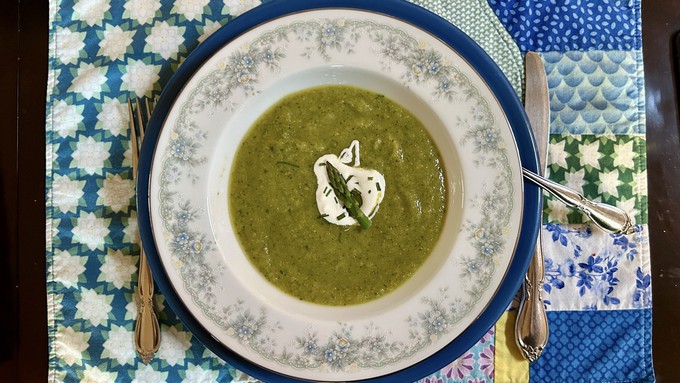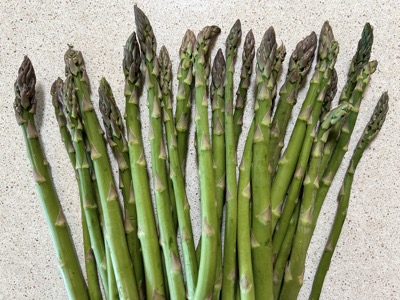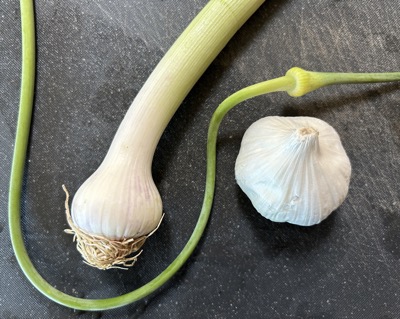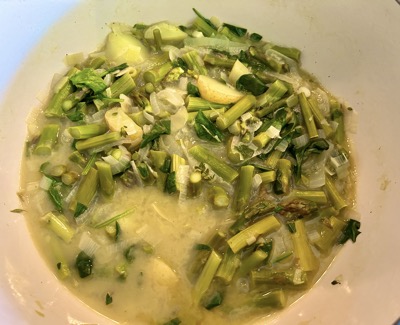
Recipe: Spring asparagus blends well with green garlic

Serve the soup chilled but not ice-cold for best flavor. Top with crème fraîche, chopped chives and a blanched asparagus top. Kathy Morrison
When the weather heats up, thoughts turn to chilled food.

This recipe uses the tender asparagus that is still in season, plus green garlic (immature garlic that's been thinned) and garlic scapes, which are the pre-bloom garlic flower stems. Regular garlic cloves can substitute for green garlic and scapes. A couple of small yellow potatoes cook along with the aromatics, giving the soup a creamy structure without the use of cream or other dairy.
However, a dollop of crème fraîche makes a lovely garnish, if you're so inclined. (Add some chopped chives and a thin asparagus spear for a dressier serving.)
The soup goes together quickly, but do allow time for it to cool to room temperature before blending -- much safer that way. The chill time is 3 hours or more, but you can speed that up by putting the soup and/or the serving bowls in the freezer for a short time. (Don't freeze it solid!)
Chilled asparagus soup
Serves 4 to 6
Ingredients:
1 tablespoon olive oil
1 large sweet onion, white or yellow

1 stalk of green garlic plus 4 garlic scapes, chopped, or 3 minced garlic cloves
1 to 2 teaspoons fresh thyme leaves
1 tablespoon chopped fresh parsley
Salt
Freshly ground black pepper
1 to 2 small yellow young potatoes, about 4 ounces total, diced (no need to peel)
1 pound asparagus, preferably thin spears, cut into 1-inch lengths
3 to 4 cups vegetable or chicken stock
1 tablespoon fresh lemon juice
2 to 3 ounces fresh baby spinach, optional
For garnish:
Crème fraîche
1 small bunch chives, chopped
Instructions:
Heat the olive oil in a large saucepan or Dutch oven over medium heat. Peel the onion, cut it in half and slice thinly. Add onion slices to the pot. Sauté until limp, then add the chopped garlic, the thyme and parsley, and a bit of salt and pepper.

Cook for another 2 to 3 minutes, then add the diced potatoes. Reserve 6 of the thinnest asparagus tops for garnish, and add the rest of the asparagus pieces to the pot. Stir to combine, and pour in 3 cups of the broth. Add a pinch of salt and a grind or two of pepper.
Bring to a boil, then simmer until the potatoes and asparagus pieces are tender, about 10 minutes.
Remove the pot from the heat and add the lemon juice and a couple handfuls of the baby spinach, if using, stirring until the spinach is limp.
Allow the soup to cool to room temperature, then blend it to a creamy consistency using an immersion blender or, in batches, a standard blender. Add a little more broth if it seems too thick.
Pour the blended soup into a glass or ceramic container (a 2-quart measuring cup is ideal) and chill at least 3 hours. It tastes better cool but not ice-cold.
To prepare the asparagus tops for garnish, place them in a heatproof dish or measuring cup. Pour about 1 cup boiling water over the tops, and let them sit for 15 seconds. Then drain the hot water and immediately pour cold water over the asparagus tops. Drain that and pat them dry.
Chill serving bowls if desired. When ready to serve, ladle the soup into the bowls, and garnish each serving with a large dollop of crème fraîche, a pinch of chopped chives and one of the blanched asparagus tops.
Comments
0 comments have been posted.Sacramento Digs Gardening to your inbox.
Sites We Like
Garden Checklist for week of July 21
Your garden needs you!
* Keep your vegetable garden watered, mulched and weeded. Water before 8 a.m. to reduce the chance of fungal infection and to conserve moisture.
* Feed vegetable plants bone meal, rock phosphate or other fertilizers high in phosphate to stimulate more blooms and fruiting. (But wait until daily high temperatures drop out of the 100s.)
* Don’t let tomatoes wilt or dry out completely. Give tomatoes a deep watering two to three times a week.
* Harvest vegetables promptly to encourage plants to produce more. Squash especially tends to grow rapidly in hot weather. Keep an eye on zucchini.
* Pinch back chrysanthemums for bushy plants and more flowers in September.
* Remove spent flowers from roses, daylilies and other bloomers as they finish flowering.
* Pinch off blooms from basil so the plant will grow more leaves.
* Cut back lavender after flowering to promote a second bloom.
* It's not too late to add a splash of color. Plant petunias, snapdragons, zinnias and marigolds.
* From seed, plant corn, pumpkins, radishes, winter squash and sunflowers.